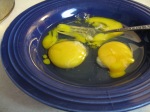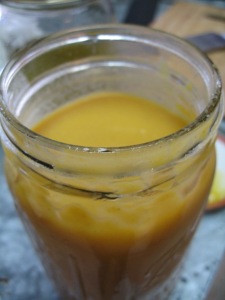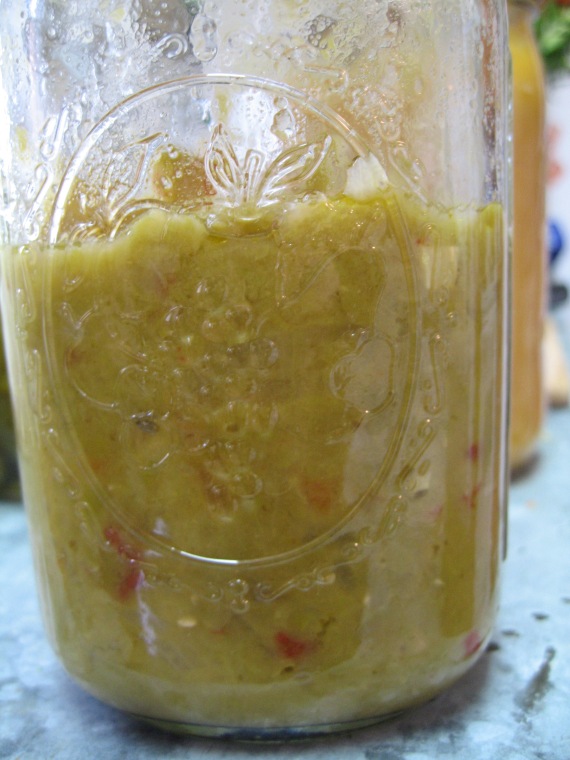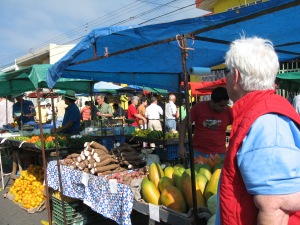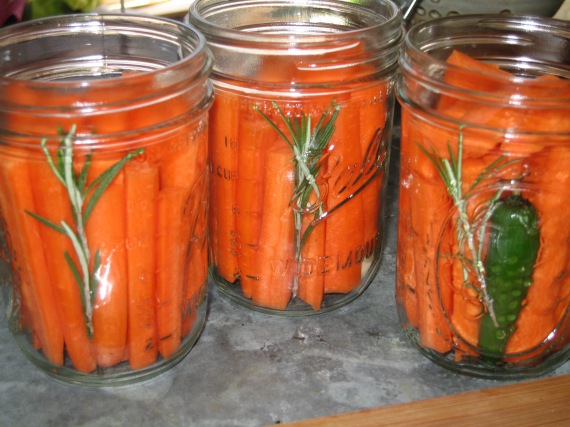
Me, pulling green onions from my garden.
Wow! Finally the food of the month is something I have in my own garden. I don’t have to go to the store or anything. After foreign oranges and carrots, I can do something local. See, that’s me right there, pulling them up myself. I was so happy to be able to do this one right. I pulled up all the remaining green onions I had in a bed, that had once grown irises, yarrow and coreopsis, among many other things. My current desire for more local food has forced me to convert several flower beds to vegetables. Over the winter, I also had carrots and beets out in that same bed, but, unfortunately, I had eaten all the carrots before the carrot challenge was announced.
In a very busy weekend I worked half a day on Saturday, worked in the garden in the afternoon, supervising my young helper, Holmes, while he was turning compost and spreading it on my asparagus bed; then, on Sunday, a friend came out to hang out and make two batches of mozzarella. We went out to the dairy that is about 20 minutes from my home , got the milk and made the cheese. After she left, taking a jar of the Rosemary Pickled Carrots with her, I also made a batch with Patrick, my DH, who wants to move right ahead to gouda and cheddar. We made ricotta from all the whey left from all that cheesemaking. Then I pulled those onions and washed them about 10 times. I kept remembering that botulism spores reside in the soil. I don’t want botulism, so I kept washing.

Prepared for the soak.
The only canning recipe I could find for scallions or green onions was Pickled Scallions on several websites. So I went with that. After they were washed, I cut them to fit the 1/2 pint jars and stacked them in layers in a bowl with salt, covered them with water and allowed them to sit overnight.
That leaves me where? Monday morning to make pickles before, I say before, I go to work. I was up at 5:00 and moving slowly. My first problem, was realizing that the tiny little half-pint jars would not sit in the rack in my water bath canner. Now what do I do? So I got out my Revere Ware stock pot. I only had enough for 4 jars, so they would fit in that, but how to keep them from jostling into each other. Somewhere I had read that someone put a dish towel in the bottom of the pot and that kept them steady. It sounded half-baked, but I was desperate at that moment. I had to get this done and go to work. So I put the water on to boil.

I then prepared the spice bag to boil in the vinegar. The recipe called for pure vinegar, no water to dilute it. That made me feel better about the botulism. It had only 2 Tablespoons of sugar in 3 cups of vinegar. It called for white, I had cider and besides, what I had was organic. Who knows what is in that white vinegar. The recipe called for whole allspice, which I did not have, mustard seed and whole peppercorns, which I did. I punted and used whole cloves instead of the allspice. I hung the bag on the pot handle and draped it into the caramel colored vinegar and turned on the heat. Then I packed the jars with the onions, a garlic clove and a bay leaf; then placed them just so on the counter.

So far, all was well. Or, at least so I thought. I poured the vinegar in and put on the lids. Now, how do I get these jars in a pot of almost boiling water with a dish towel floating around in it. It was supposed to lie on the bottom and behave, but that is not what it was doing. It was flapping about crazily and there was no way it was going to protect my jars from jouncing around in the hot water. The other thing I noticed was that there were suds in the pot. My dish towel apparently had not been rinsed thoroughly in the washing machine. I don’t want sudsy tasting pickled scallions. It is now about 6:30. I have to be at work at 8:30. I dumped out the pot rinsed it several times and refilled it with clean clear water and waited for it to heat up.

Busted jars.
It took longer than you would think for that to happen. I just sat and watched the pot come near a boil. I never thought about how much the jars had cooled down by this time. I also had nothing in the bottom of the pot to cushion the fall of the first jar that slipped from my jar tongs and banged into the bottom of the pot turned over and popped. The entire bottom sheared off. I fished it out. Somehow the onions all stayed in. The next jar went as peacefully as you please. The third jar was going good, but then I heard that pop again. The bottom had broken off that one, too. All the vinegar rushed out while I held the jar with the scallions remaining suspended in the jar tongs. I sat it down beside the other broken jar and crossed my fingers. The last one was no problem. They sat on opposite sides of the pot and I put the lid on and set the timer. 15 minutes I had to wait.
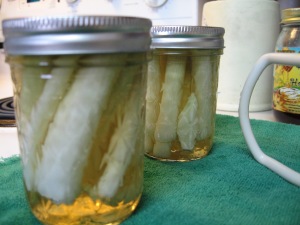
They rattled away in the pot, but no pops or crashes. At fifteen minutes, I took off the lid, lifted the two jars out and set them on the towel to cool and seal. It occurred to me then that I did not know what one did with pickled scallions. Do you just eat them out of the jar like the pickled carrots? Do you put them in cocktails? Do you just admire them on the shelf? The thing that I was really wondering about, was what I was going to do with the mountain of green onion tops that I had left over. I wrapped them up and put them in the refrigerator to use in salads and such, but would we really be able to eat them all before they wilted? This seems like one of the more wasteful kinds of pickles that you could make. I still had to get ready to go to work, but I was really hungry by this point, and what is better in scrambled home grown eggs than green onions? I chopped up some of the tops and made me a lovely plate of scrambled eggs and whole wheat toast.
The Recipe – Pickled Scallions
To make 4 half-pint jars
48 green onions
3 cups apple cider vinegar
1/2 cup salt
2T sugar
2 T whole cloves
1 T whole mustard seeds
1 T whole peppercorns
4 bay leaves
4 cloves garlic
Wash and trim scallions to fit in jars. Remove the tough outer layer of skin. Wash again. Place the scallions in layers in a bowl, sprinkling each layer lightly with some of the salt. Cover the cold water and let stand 12 hours or overnight, making sure scallions stay submerged in water. Drain the scallions, rinse then in fresh water and drain again. Combine the sugar and vinegar. Add the spices together and tie up in a cheesecloth bag. Bring to a boil and simmer 15 minutes. Discard the spice bag. Pack the scallions, standing upright into sterilized jars. Add one bay leaf and one clove of garlic to each jar. Fill the jars to within 1/2 inch of the top with the boiling liquid and place the covers on loosely. Place the jars in hot water bath and process for 15 minutes. Remove and let them cool and seal.Buy a mini canning rack from Amazon that fits in a Revere Ware stock pot. These pictures won’t line up like I want them to, but here they are anyway. That’s my blood orange marmalade on the toast. A lovely breakfast and off to work.
